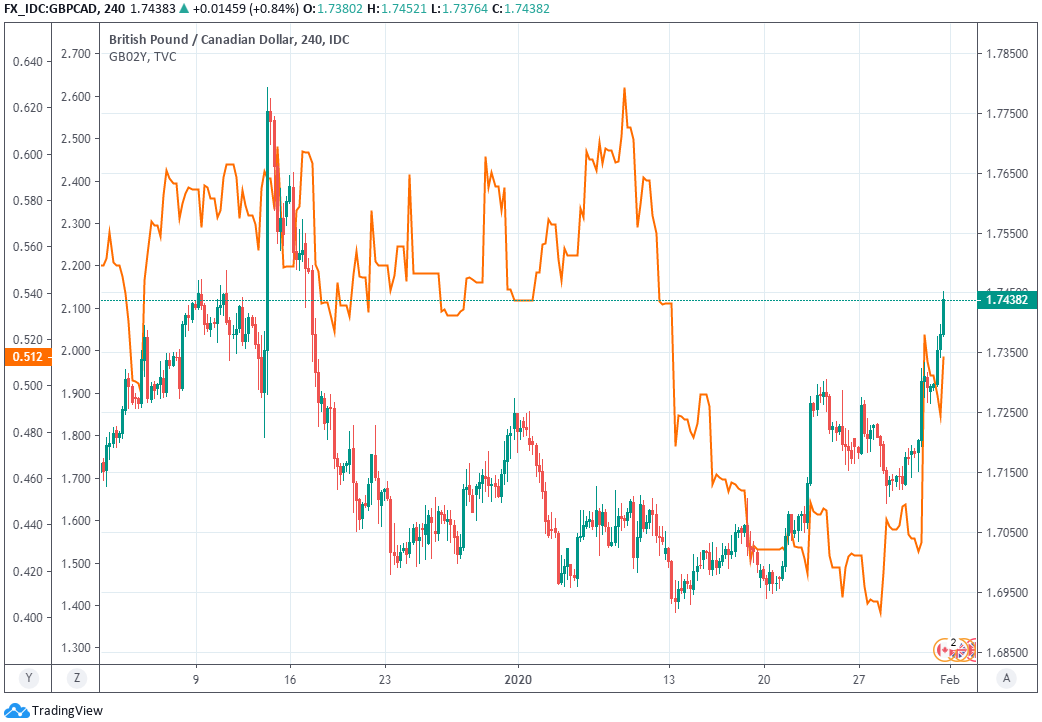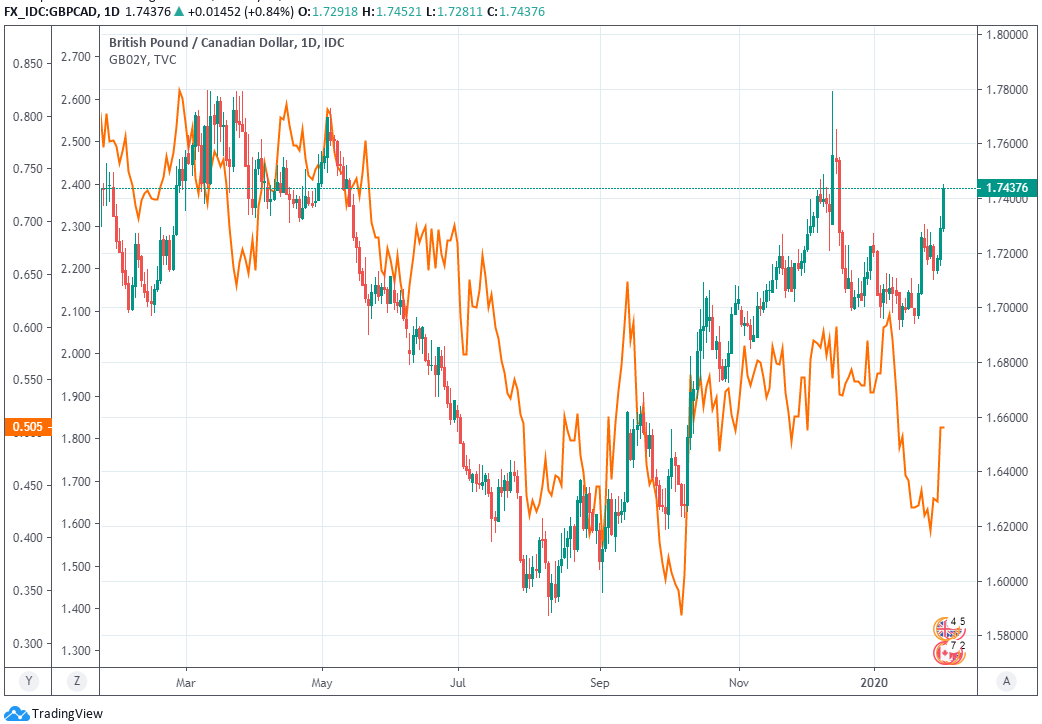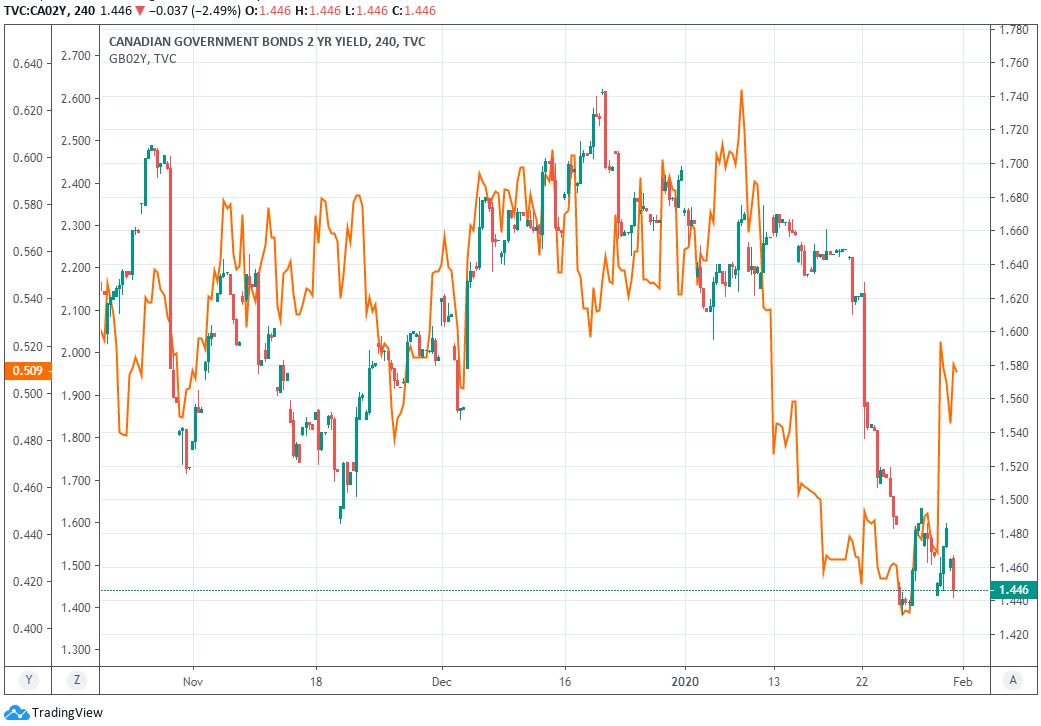Pound-Canadian Dollar Rally Endures as GDP Growth Beat Overlooked amid Virus Fears
- Written by: James Skinner
-
- GBP/CAD rally endures even after CA GDP beats expectations.
- As oil prices crash and bond yields fall amid coronavirus fears.
- Chinese economy grinding to a standstill as infection spreads.
- Virus now a global emergency, WHO says, as concern rises.

Image © Pavel Ignatov, Adobe Stock
- GBP/CAD Spot rate: 1.7396, up 0.67% today
- Indicative bank rates for transfers: 1.6793-1.6915
- Transfer specialist indicative rates: 1.7141-1.7245 >> Get your quote now
The Pound-Canadian Dollar rate rally endured Friday even after Canada's November GDP beat expectations, with the Loonie unable to capitalise on the goods news amid mounting concern over the spread of coronavirus, which has walloped oil prices and wounded commodity currencies.
Canadian GDP increased 0.1% in November, reversing an equally-sized contraction from October when the market was confident it'd be left unchanged following an anticipated 0% reading. And gains were seen in some sectors of the economy that had all but been written off for the final quarter.
"It was no surprise that retail showed strength, given the earlier report, but construction posted a healthy gain despite little signs of advance in recent housing data, not to mention unseasonably cold weather during the month. That same weather boosted utilities usage during the month, but that will likely be reversed in upcoming reports. Manufacturing also eked out a flat reading despite the earlier sales report which suggested a material decline," says Royce Mendes, an economist at CIBC Capital Markets.
That should have been good news for the Loonie given Bank of Canada (BoC) concerns about the pace of growth in the final quarter and uncertainty about the outlook for a 1.75% cash rate that's made the Canadian Dollar an attractive prospect over the last year. Investors have been starved of 'yield' since the Federal Reserve began cutting rates across the southern border last July.

Above: Pound-to-Canadian Dollar rate at 4-hour intervals alongside two-year GB government bond yield (orange)
Sterling has continued to benefit from a spike in British bond yields that was instigated by a Bank of England (BoE) decision to leave rates at 0.75% Thursday, in what turned out to be not nearly as close a call as markets had thought it would. That's lifted the Pound against all majors heading into the weekend, making it the best performer for the week even as the country prepares for a technical and legalistic departure from the EU at 23:00 Friday.
"At 23:00 GMT, which is the benchmark for world time, the European Union will break up. As Britain embarks on this new chapter, it is important to recognize that this is not the first time an attempt to unify the entire continent - or a large part of it - will have failed," says Stephen Gallo, European head of FX strategy at BMO Capital Markets. "While the UK's "one nation Brexit" immediately opens the door to all sorts of strategic reforms, Brussels cannot even begin to tackle the most important "local problems" at the level of individual member states until it resolves the EU-27 cohesion dilemma first."
Gallo prefers betting on an increase in the Pound-to-Euro rate rather than a fall, even as the UK makes an EU exit that was long forecast by many to be a harbinger of all manner of short and long-term problems for the economy. However, and when it comes to other currencies, he tips the U.S. Dollar for outperformance against riskier prospects like the Pound and Canadian Dollar.
The Pound-to-Canadian Dollar rate always closely matches the sum of GBP/USD over CAD/USD so can be characterised as a bit of a race between Sterling and the Loonie, against the U.S. greenback. And in any such race that takes place amid a deterioration of investor appetite for risk, the Pound can normally be expected to win because the Canadian Dollar has more of an exposure to risk-sensitive commodity prices than its British counterpart. 
Above: Pound-to-Canadian Dollar rate at daily intervals alongside two-year GB government bond yield (orange)
"We cannot know for sure which twist or turn the Coronavirus situation is going to take next. But given the downside risks to Q1 Chinese economic growth, much of the recent rally in USDCNH is likely to stick for the time being, or at least until the direct impact of the outbreak on the data becomes clearer," Gallo says. "China will probably want to use all the levers at its disposal to set the pace and timing of RMB weakness."
Markets are increasingly attuned to the threat posed by China's new pneumonia-like coronavirus, which has spread to at least 20 other countries and led the World Health Organization to declare a global emergency on Thursday. The virus has threatened to bring China's economy to a near-standstill this last week and was confirmed to have reached the UK Friday, with two intrafamily cases reported. Canada has three cases.
Chinese cities are turning to ghost towns as the public isolate themselves to avoid infection. That explains in large part why a government economist said on Wednesday that GDP growth could fall below 5% this quarter, from 6% previously - a slowdown that'd likely be felt far beyond China's borders. This has multiple direct implications for the Loonie ranging from the depressing impact on prices of oil, Canada's largest export, to the damage it might do to the export sector and houshold confidence.
"While global yields are poised to remain low and the Bank of Canada’s “dovish hold” last week supports the outlook for somewhat lower rates in Canada this year, markets are pricing in about the same degree of easing into the CAD OIS curve over the coming 12 months as the USD OIS curve at moment. Short-term yields in Canada and the US remain close to par (at the 2Y sector of the curve). Yield differentials may not move that much and, if they do diverge somewhat, the CAD is set to remain a relatively high yielder in the G-10 space," says Shaun Osborne, chief FX strategist at Scotiabank.

Above: Two-year CA government bond yields alongside GB counterparts (orange). Both shown at daily intervals.
The risks emanating from China and spreading across the globe could mean the Pound-Canadian Dollar rate rally is set to extend at least in the short-term although if the Chinese authorities are able to get a grip on the situation and infections in places like the UK and Canada remain low in number as well as contained, then the tables could soon turn on the Pound.
British bond yields have defied the gravity that's pulled other major economy yields lower this week as investors become increasingly concerned about the size of the possible economic impact resulting from the international spread of China's new coronavirus. This could mean a correction is in store for Sterling's yield if pandemic fears fade and investors turn their attention back to the BoE and market-perceived probability of a rate cut coming in the months.
"Markets heavily trimmed their bets for a BoE cut at Bailey’s first meeting at the helm of the Bank in March to around a 10-15% chance, down from ~60- 65% prior to the BoE’s announcement and from as high as ~90% two weeks ago," says Scotiabank's Osborne. "A repeat performance for G-10 Carry strategies this year might still involve the CAD."
The BoE may have sat on hold this Thursday but that was only because it's willing to bet on a rebound in UK growth over the coming months.

Above: Pound-to-Canadian Dollar rate at weekly intervals alongside two-year GB government bond yield (orange)
A UK growth rebound may or may not be forthcoming even without a further spread of coronavirus, although if that recovery doesn't come then the BoE could be forced to cut rates before long, weighing on the Pound in the process.
Much currently depends on whether PMI surveys are right about a January growth rebound when those surveys have been terrible predictors of economic outcomes during times of political decision-making on Brexit.
And a lot also depends on whether Prime Minister Boris Johnson is able and willing to deliver on his word now that markets are banking on a large fiscal stimulus being delivered on March 11.
Any gimmick-like shifting of numbers on the balance sheet come March 11, rather than an actual expansion of the balance sheet that stems from new-money spending commitments, could easily see markets return to pricing-in imminent rate cuts from the BoE. And that would weigh heavily on Sterling after this week's price action, including the Pound-to-Canadian Dollar rate.









